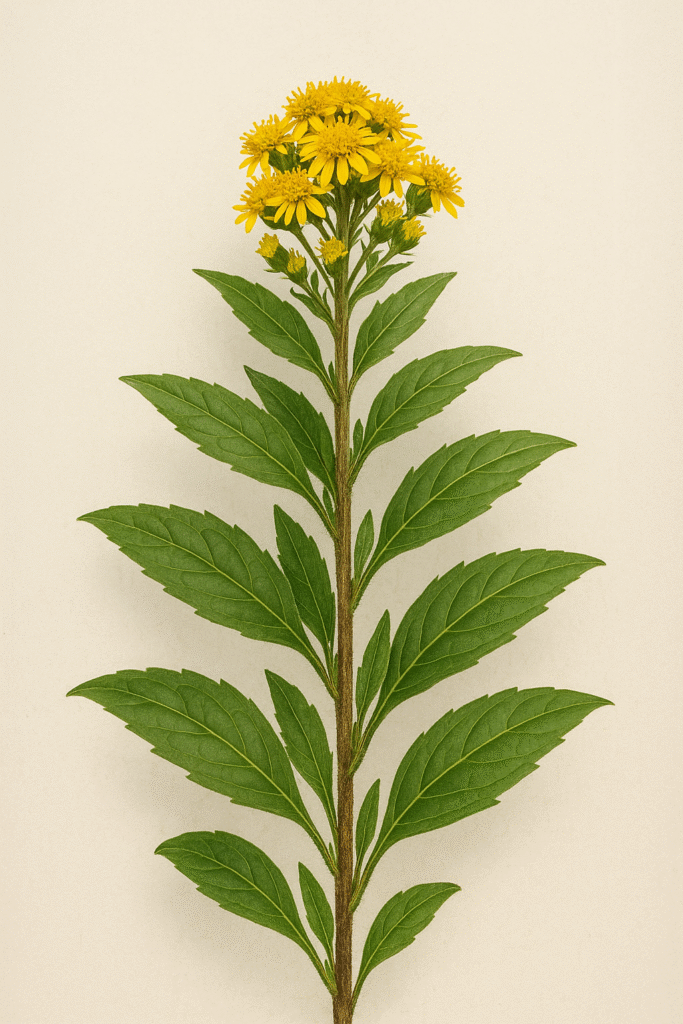Brazilian arnica, known scientifically as Solidago chilensis, is a medicinal plant native to South America and widely found across Brazil. Also referred to as arnica-do-campo or wild arnica, it’s highly valued in traditional medicine for its powerful anti-inflammatory properties. Commonly used to relieve muscle pain, bruises, and swelling, this plant has become a staple in natural remedies throughout the country.
In this article, we explore the key health benefits, common applications, safety precautions, and interesting facts about Brazilian arnica.
What Is Brazilian Arnica?
Solidago chilensis belongs to the Asteraceae family, which includes daisies, sunflowers, and chamomile. It typically grows in open fields, along roadsides, and in grasslands—especially in southern and southeastern regions of Brazil. While often confused with the European arnica (Arnica montana), Brazilian arnica is a different species with a unique chemical composition, yet similar medicinal properties.
The leaves and flowers of the plant are the most commonly used parts, containing active compounds with anti-inflammatory, analgesic, and healing properties.
Main Health Benefits of Brazilian Arnica
1. Relieves Muscle Pain and Injuries
One of the most well-known uses of Brazilian arnica is in treating physical trauma such as sprains, bruises, muscle soreness, and minor injuries. Its compounds help reduce inflammation and ease pain naturally.
2. Natural Anti-Inflammatory Action
The plant contains flavonoids and sesquiterpene lactones, which work to reduce inflammation and improve local circulation. It is often used in cases of arthritis, rheumatism, and joint discomfort.
3. Promotes Wound and Bruise Healing
Brazilian arnica also assists in the healing of superficial wounds, and helps the body reabsorb blood from bruises more quickly. It’s often applied after falls or minor accidents to speed recovery.
4. Soothes Post-Workout Soreness
Athletes and fitness enthusiasts often use arnica-based creams or gels to relieve muscle fatigue and soreness after intense exercise or physical activity.
How to Use Brazilian Arnica
● Compresses
Make a strong infusion of the plant’s leaves and flowers, soak a clean cloth, and apply it as a topical compress to the affected area.
● Creams and Ointments
Commercial and handmade creams with Brazilian arnica extract are widely used. They are easy to apply and deliver fast relief for localized pain and inflammation.
● Tincture
A concentrated liquid made with alcohol and arnica can be diluted and applied externally as a compress or added to bathwater for muscle relaxation.
⚠️ Warning: Brazilian arnica is not safe for internal use. Ingesting it may lead to toxic effects, including nausea and liver issues. Only apply externally.
Cautions and Contraindications
Despite its natural origin, arnica-do-campo requires responsible use. Some important precautions include:
- Do not apply to open wounds with active bleeding.
- Perform a skin sensitivity test before full application.
- Avoid use in pregnant or breastfeeding women unless advised by a health professional.
- Discontinue use in case of itching, redness, or skin irritation.
Long-term or excessive use can lead to dermatitis or allergic reactions, especially in sensitive individuals.
Brazilian Arnica vs. European Arnica
While both Brazilian arnica (Solidago chilensis) and European arnica (Arnica montana) share anti-inflammatory properties, they are botanically distinct. The European version is more commonly used in international herbal medicine, while the Brazilian species is well-adapted to local climates and equally effective for topical use.
Interesting Facts About Solidago chilensis
- It grows naturally in nutrient-poor soils, often in open fields and pastures.
- The plant can grow up to 1 meter (3 feet) in height.
- Its yellow flowers are not only medicinal but also attract pollinators.
- In some local traditions, the plant is used in rituals and folk healing for protection and energy cleansing.
Final Thoughts
Brazilian arnica is a treasured medicinal plant of the South American flora, known for its effectiveness in treating pain, inflammation, and minor injuries. Whether used as a compress, cream, or tincture, it remains a reliable and accessible option for those seeking natural remedies.
Still, it’s essential to respect its powerful compounds and avoid internal use. For safe and effective treatment, consult a doctor or herbalist—especially when dealing with chronic conditions or sensitive skin.

Elevate Your Plant Display in Style
Showcase your greenery with the ROSSNY 48-Inch Tall Plant Stand — a 6-tier bamboo design that holds up to 7 pots, perfect for corners and adding a natural touch to your indoor space.
- 6 tiers for a stunning vertical display
- Holds up to 7 potted plants
- Durable and eco-friendly bamboo
- Perfect for living room, balcony, or office
Discover the Healing Power of Canela-de-Velho
Learn about Canela-de-Velho — the medicinal plant traditionally used to relieve joint pain and improve mobility. Explore its benefits, uses, and preparation methods.
- Known for anti-inflammatory properties
- Used in natural joint pain relief
- Traditional herbal medicine in Brazil
- Preparation and dosage tips

